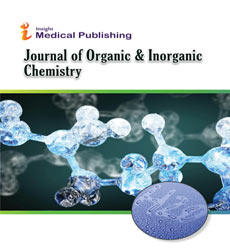Carboxylic Acid-Containing Drugs: Balancing Efficacy and Toxicity in Drug Design
Thomas Austin
Department of Chemical Engineering, Heilongjiang University of Science and Technology, Harbin, China
Published Date: 2024-12-09DOI10.36648/2472-1123.10.4.100
Thomas Austin*
1Department of Chemical Engineering, Heilongjiang University of Science and Technology, Harbin, China
- *Corresponding Author:
- Thomas Austin,
Department of Chemical Engineering, Heilongjiang University of Science and Technology, Harbin, China
E-mail: Austinthom@ha.au
Received date: November 25, 2024, Manuscript No. IPJOIC-24-20050; Editor assigned date: November 28, 2024, PreQC No. IPJOIC-24-20050 (PQ); Reviewed date: December 12, 2024, QC No. IPJOIC-24-20050; Revised date: December 19, 2024, Manuscript No. IPJOIC-24-20050 (R); Published date: December 26, 2024, DOI: 10.36648/2472-1123.10.4.100
Citation: Austin T (2024) Carboxylic Acid-Containing Drugs: Balancing Efficacy and Toxicity in Drug Design. J Org Inorg Chem Vol.10 No.4: 100.
Description
Carboxylic acids are critical pharmacophores in various drug classes, especially Non-Steroidal Anti-Inflammatory Drugs (NSAIDs). However, some common metabolic pathways involving conjugative reactions of carboxylic acid-containing drugs can lead to the formation of reactive metabolites, which are responsible for drug toxicity. Research has highlighted that reactive metabolites, such as S-Acyl-CoA thioesters and Acyl Glucuronides (AGs), can contribute to the toxicity of these drugs. This toxicity arises from the chemical reactivity of the metabolites formed during biotransformation, which may lead to protein adduct formation, a major mechanism underlying druginduced toxicity. Acyl glucuronides, including 1-β-O-AGs, are prone to undergoing several chemical reactions at physiological pH. These reactions include acyl migration (transacylation), mutarotation and hydrolysis, resulting in a range of positional isomers such as 1-α, 2-α, 2-β and others. The rate of degradation of AGs, or the degradation constant (kd), reflects the speed at which these transformations occur and can be used to assess the likelihood of toxicity due to the formation of reactive intermediates. The degradation rates are influenced by factors such as pH, temperature, the structure of the aglycone and the reaction medium. Understanding the degradation rate (kd) of AGs is critical for evaluating the potential toxicity of drugs. Drugs that form AGs with high degradation rates may be more likely to form reactive metabolites, leading to protein adducts and subsequent toxicity. Therefore, drug design efforts often focus on developing compounds with slower AG degradation rates to reduce toxicity risks. Kinetic modelling of AG degradation has been an active area of research. Several studies have employed different computational methods to model the degradation reactions, including acyl migration and hydrolysis. These models aim to predict the degradation rate of AGs and their potential toxicity based on structural parameters and experimental data.
Structure-property relationships
Recent efforts have focused on developing Structure-Property Relationships (SPR) to predict AG degradation rates. These models consider various molecular properties, including pKa, hammett constants, partial atomic charges, taft steric constants and neuclear magnetic resonance chemical shifts. By integrating these properties, researchers can create models that accurately predict the degradation rates (kd) of AGs, which are key for assessing the potential toxicity of carboxylic acid-containing drugs. In addition to these empirical models, in silico approaches such as Density Functional Theory (DFT) and transition-state modeling have been employed to understand the underlying mechanisms of acyl migration, mutarotation and hydrolysis in AG degradation.
NSAID(Non-Steroidal Anti-Inflammatory Drugs)
The most recent kinetic modelling studies have focused on NSAID AGs, including ibufenac and the R- and S-isomers of ibuprofen, as well as their α, α-dimethyl substituted analogue 'bibuprofen'. These NSAID AGs are compared to a previously studied series to investigate structural differences and their effects on degradation rates. The NSAID AGs contain an isobutyl substituent at the 4-position, this structural difference may contribute to variations in the reactivity of the two series. DFT calculations have been employed to model the transacylation reactions of these NSAID AGs, with activation energies calculated and compared to experimental values. The kinetic modelling of these NSAID AGs includes analysis of the transacylation, mutarotation and hydrolysis reactions, which are vital for understanding their reactivity and potential for toxicity.
Conclusion
Kinetic modelling plays a vital role in understanding the degradation of Acyl Glucuronides (AGs) and their potential for causing toxicity. By studying the degradation rates of NSAID AGs and comparing them to other AG series, researchers aim to develop predictive models that can help identify compounds with reduced toxicity potential. Structural differences, such as steric hindrance and the presence of substituents, significantly affect the reactivity of AGs and understanding these factors is key to designing safer drugs. Ultimately, predictive models based on kinetic data, structure-property relationships and computational approaches will continue to be instrumental in the development of drugs with minimized risk of reactive metabolite formation.
Open Access Journals
- Aquaculture & Veterinary Science
- Chemistry & Chemical Sciences
- Clinical Sciences
- Engineering
- General Science
- Genetics & Molecular Biology
- Health Care & Nursing
- Immunology & Microbiology
- Materials Science
- Mathematics & Physics
- Medical Sciences
- Neurology & Psychiatry
- Oncology & Cancer Science
- Pharmaceutical Sciences
